Hoplite › The Arch of Titus, Rome » Ancient origins
Articles and Definitions › Contents
- Hoplite › Ancient History
- The Arch of Titus, Rome › Antique Origins
Ancient civilizations › Historical and archaeological sites
Hoplite › Ancient History
Definition and Origins
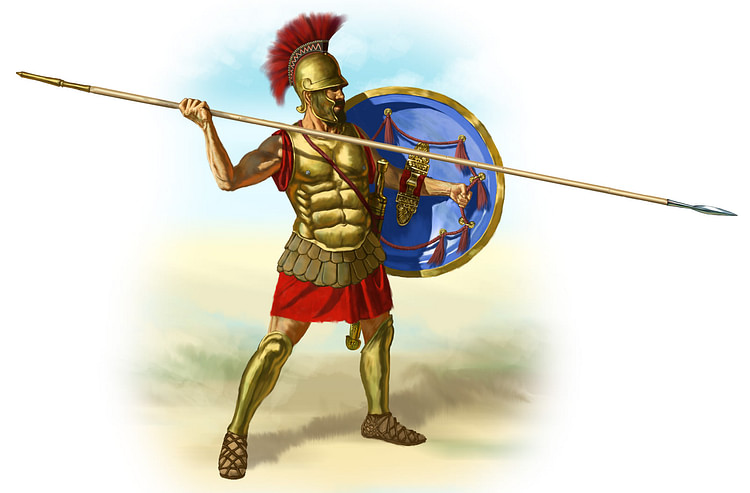
A hoplite (from ta hopla meaning tool or equipment) was the most common type of heavily armed foot-soldier in ancient Greece from the 7th to 4th centuries BCE, and most ordinary citizens of Greek city -states with sufficient means were expected to equip and make themselves available for the role when necessary.
Athens had a system of compulsory military service for 18-20 year olds, but during a war all male citizens up to the age of 60 could be called up to the armed forces. Other city-states followed a similar policy which meant that hoplites were not professional soldiers and often lacked sufficient military training, although some states did maintain a small elite professional unit, the epilektoi. The most famous of these was the Sacred Band of Thebes, a unit composed of 150 pairs of male lovers who swore to defend their partner to the death. Sparta, where all male citizens over 20 were members of a permanent professional army, was the notable exception to this approach of only calling up an army when absolutely needed.
THE PRINCIPAL WEAPONS OF A HOPLITE INFANTRYMAN WERE A LONG ASH WOOD SPEAR (DORU) & A SHORT SWORD (XIPHOS).
WEAPONS & ARMOUR
The principal weapons of a hoplite infantryman were a long ash wood spear ( doru ) and a short sword ( xiphos ). The spear measured on average 2.5 metres (8 ft.) in length and was fitted with a bronze or iron blade and a four-sided end spike ( sauroter ). The sword was also of iron with a straight or sometimes curved blade ( machaira or kopis ) no more than 60 cm in length. No doubt many hoplites also carried a dagger ( encheiridion ) as an extra insurance. Protection was provided by a leather-lined bronze helmet which could vary in design, was often crested, and protected the head, neck, and face. A corselet or breastplate ( thorax ) of bronze or leather (later reduced to a laminated linen vest to save weight - a linothorax ), bronze greaves ( knemides ) to protect the shins, and sometimes arm-guards were also worn. The hoplite carried a large circular shield ( hoplon or aspis ) some 80 cm (30 in.) in diameter and weighing as much as 8 kg. This was made of wood or stiff leather, faced with bronze, and was held with the left arm placed through a central band ( porpax ) and gripped via a strap ( antilabe ) attached to the shield rim. Shields often carried particular designs - the most famous being the inverted V-shape of Spartan hoplites - and emblems - particularly popular was the gorgon from Greek mythology with its association with changing the onlooker into stone. Surviving examples of breastplates and helmets also display engraved decoration. Fully armoured then, the hoplite was required to carry some 20 kg of equipment and so good physical training must have given one side a strong advantage (eg the well-trained and professional Spartans). Precisely because all of this equipment amounted to quite an investment, being a hoplite also indicated that the individual had a certain status in wider Greek society.
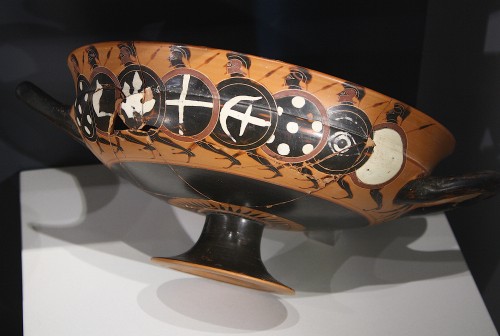
Greek Hoplites
HOPLITE PHALANX
Hoplites were organised into regiments or lokhoi (several hundred men strong), and they fought in ranks eight or more men deep (known as a phalanx), and standing close together, half of the shield of one man protected his neighbour on his left side.This, interestingly, meant that the phalanx often moved forward at a slight angle to the right as men sought to keep behind the shield of their neighbour. This resulted in the left flank usually breaking formation first, and so this was the flank a competent commander would attack with priority, and he would therefore ensure he had his best troops on his own right flank. The phalanx advanced at a walk or faster, often accompanied by rhythmic music from aulos players, and shouting a tremendous war-cry ( paean ). On engaging the enemy the hoplites first thrust their spears, usually over-arm. After that initial contact the opposing lines usually went through a series of pushing and shoving ( othismos ) and close-quarter fighting with swords which only ended when one side broke ranks. Pursuit of retreating hoplites was usually only over a short distance in order to maintain the protective close-formation.
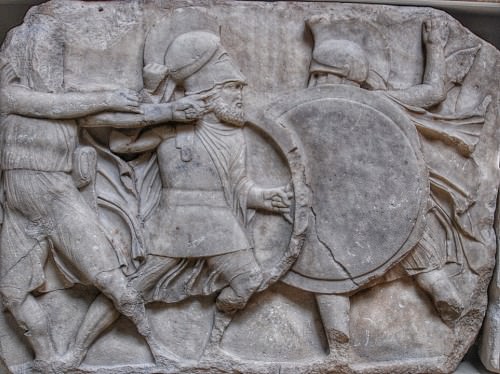
Greek Hoplites Fighting
Hoplites were instrumental in the Greek victories over Persia at the battles of Marathon (490 BCE) and Plataea (479 BCE).The weaknesses of the phalanx formation - attack from the flanks, rear, or when on rough terrain - were sometimes exploited by more wily commanders; however, the formation, albeit with lighter-armed infantry, was still in use through Hellenistic and early Roman times.
The Arch of Titus, Rome › Antique Origins
Ancient Civilizations
The Arch of Titus is a Roman Triumphal Arch which was erected by Domitian in c. 81 CE at the foot of the Palatine hill on the Via Sacra in the Forum Romanum, Rome. It commemorates the victories of his father Vespasian and brother Titus in the Jewish War in Judaea (70-71 CE) when the great city of Jerusalem was sacked and the vast riches of its temple plundered.The arch is also a political and religious statement expressing the divinity of the late emperor Titus.
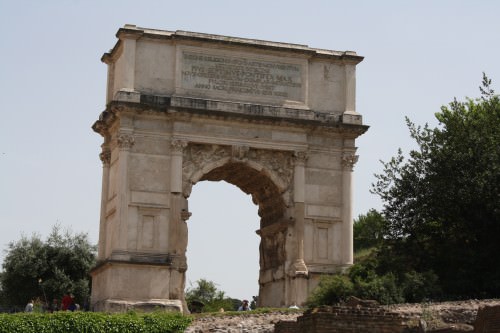
Arch of Titus, Rome
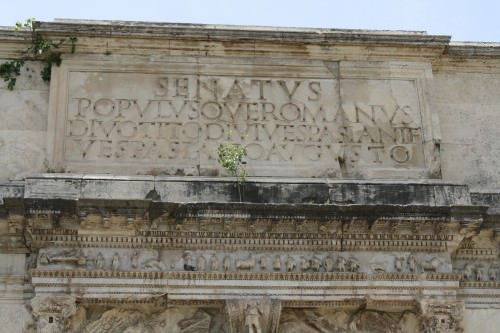
Inscription, Arch of Titus
INSCRIPTION
The arch was constructed using Pentelic marble, with the attic part in Luna marble. The original inscription on the east side of the arch is still in situ, although originally the letters would have been inlaid with gilded bronze. It reads:
SENATUS
POPOLUS QUE ROMANUS
DIVO TITO DIVI VESPASIANI F
VISPASIANO AUGUSTO
(The Senate and People of Rome, to Divus Titus, son of Divus Vespasian, Vespasian Augustus ). The use of 'Divo' for Titus indicates that the arch was erected after the death of the emperor in 81 CE. The inscription on the west side describes the refurbishment of the monument by Pope Pius VII in 1821 CE.
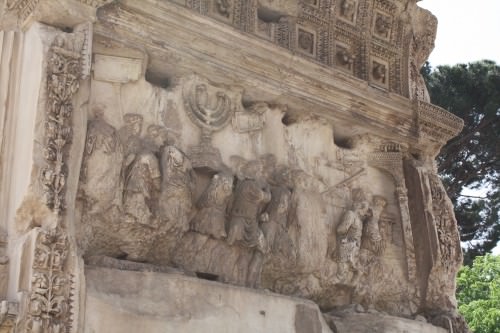
Panel, Arch of Titus
DECORATIVE SCULPTURE
With only a single opening the arch is smaller and more modest in its decoration than other surviving arches such as those of Constantine and Septimius Severus. Also, the decorative sculpture has not survived the ravages of time very well.Nevertheless, one can still see the significance of some of the sculpture scenes, notably, the side panels. These marble reliefs are set either side of the inner arch and measure 2.04 m high by 3.85 m long. One panel shows the start of Titus' 71 CE victory triumph procession as it passes through the Porta Triumphalis to the Forum Boarium with the participants carrying booty from the Temple of Jerusalem after the sacking of the city. The booty includes a seven-branched candelabra (menorah), silvertrumpets, and perhaps even the Ark of the Covenant. Some figures carry placards which would have probably indicated the names of the conquered cities and peoples.

Panel, Arch of Titus
The other relief panel is carved in three-quarter view and has Titus riding a four-horse chariot ( quadriga ) and shows him being crowned by a personification of Victory. The goddess Roma stands in front, holding the bridle of one of the horses. The two figures to the right of the chariot are personifications of the people of Rome (naked torso) and the Senate (wearing a toga).
The two relief panels are significant in the history and development of Roman art, as they are the first full attempt by Roman sculptors to create the illusion of space. This is successfully achieved in several ways; the figures are portrayed in three-quarter view, the background figures are so rendered that they recede gradually into the distance, the central figures are carved in higher relief than those on the edges, and the whole panel is curved slightly inwards.

Detail, Arch of Titus
Running around the whole arch is a small frieze which depicts the whole triumphal procession, and above the intrados winged victories each stand on a globe and hold banners, trophies, laurel wreaths, and palm fronds. Set in the centre of each side of the archway is a keystone representing Roma and the Genius of the Roman People. The interior vault is coffered with a central representation of the deified Titus (apotheosis) being carried to the heavens by an eagle. Originally, the whole arch was finished off in customary style with a huge bronze quadriga which would have stood on top of the arch.

Detail, Arch of Titus
LATER HISTORY
The arch was incorporated into fortifications built by the Frangipani family in medieval times and suffered as a consequence.The significant restoration of the monument was carried out in the 19th century CE, in particular, on parts of the piers and attic using Travertine limestone. In fact, the whole arch was dismantled and reassembled piece by piece. In the present day the foundation blocks of the arch are visible, as the original roadway would have been higher.
LICENSE:
Article based on information obtained from these sources:with permission from the Website Ancient History Encyclopedia
Content is available under License Creative Commons: Attribution-NonCommercial-ShareAlike 3.0 Unported. CC-BY-NC-SA License